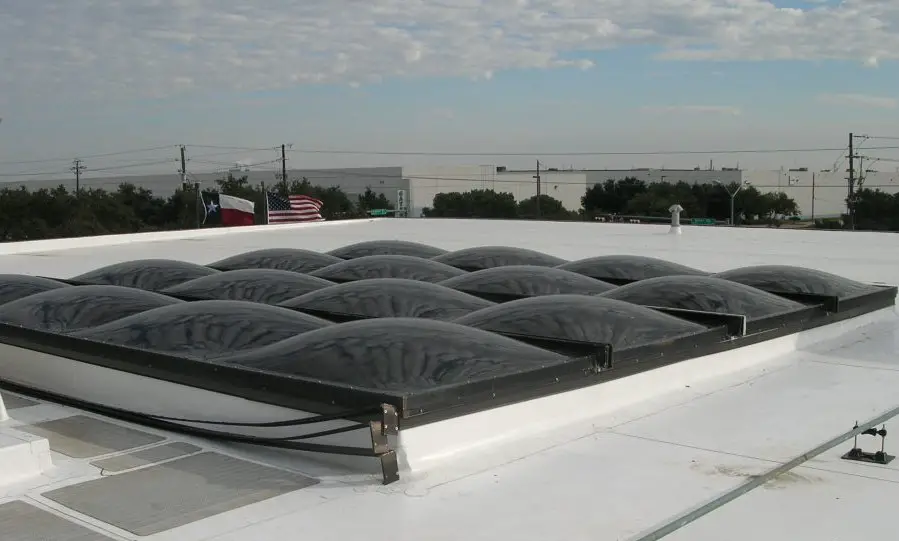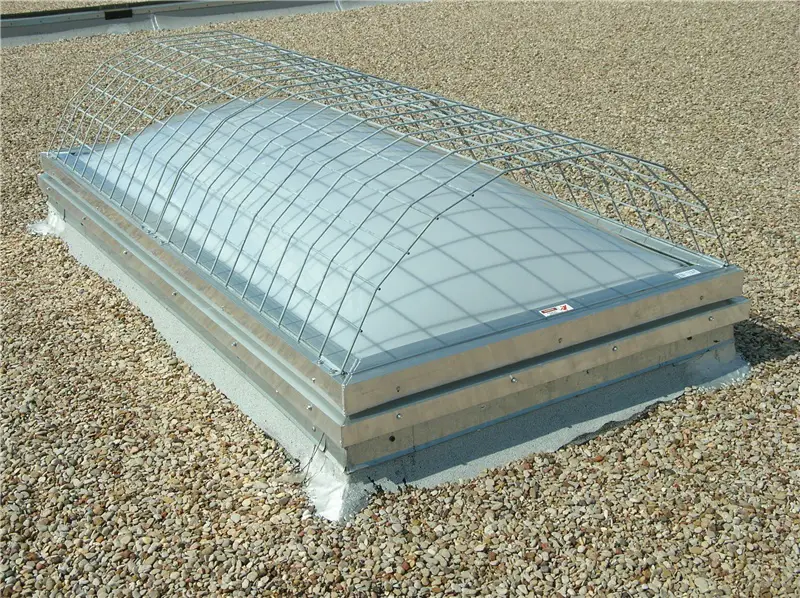Skylight Manufacturers List & Website Directory
Includes Heat and Smoke Vent Manufacturers
By Roof Online Staff • Last updated April 16, 2024
For more about skylights, see our Skylights page.
Return to the Roofing Manufacturer Directory Index

Skylights
Skylights are a popular architectural feature used to allow more natural light into a building. They are typically installed on roofs and integrated with the roofing material. While improving interior aesthetics, they can also, in some climates, improve energy efficiency by reducing the use of artificial lighting. In colder climates, this is often outweighed by the heat loss commonly facilitated by skylights.
Larger skylights are typically built on site using modular sections, especially on commercial buildings. Smaller skylights are typically prefabricated as complete units which are brought to the site and then installed. Most residential skylights are of this type.
Types of Skylights
- Fixed Skylights: These skylights don’t open. They are used to simply let in more light.
- Vented Skylights: These are also called roof windows or venting skylights. They can be opened to allow for ventilation. They can be operated manually or electrically, depending on the model.
- Tubular Skylights: These are a more recent development that channel sunlight through a reflective tube from the roof down to a lower ceiling. They can be ideal for small spaces where traditional skylights cannot be installed.
Important Considerations Before Buying Skylights
- Purpose: Determine whether you want the skylight primarily for light, ventilation, or both.
- Placement: The location of the skylight on the roof affects how much light enters and at what time of day. North-facing skylights will provide consistent but cooler lighting, while south-facing skylights can offer more heat and often direct sunlight.
- Energy Efficiency: Look for skylights with double glazing or low-emissivity (Low-E) coatings to improve thermal performance and reduce heat loss. Heat loss through skylights can be significant.
- Weather Resistance: Make sure the skylight is constructed appropriately for your local climate, especially its ability to withstand potential snow loads, hail, heavy rain, and UV exposure.
- Installation: Skylights are a notorious source of leaks. Leaks at skylights are often caused by flashing failures, where the installer fails to properly integrate the skylight with the roofing material, uses flashing material that is not high enough, or fails to install recommended crickets upslope of the skylight to direct rainwater around the unit. Proper installation is hugely important to avoiding leaks at skylights. Professional installation by an experienced, reputable installer is strongly advised to make sure it’s done correctly.
Heat and Smoke Vents
Heat and smoke vents are typically installed on the roofs of buildings in order to improve fire safety by allowing heat, smoke, and toxic gases to escape during a fire. Their use and locations in a building are mandated by code. The use of heat and smoke vents helps to reduce damage to buildings in the event of a fire and facilitates safer evacuation routes and firefighting efforts.
Heat and smoke vents are designed to either pop open or drop out in the event of a fire, and can be activated in a few different ways.
Heat and smoke vents typically look a lot like smaller prefab unit skylights and will often be referred to as skylights by people who may not be aware of their primary function. Heat and smoke vents will normally have acrylic or polycarbonate glazing and will also function as skylights, although models with steel or aluminum covers that do not let light in are also available.

Types of Heat and Smoke Vents
There are a few types of heat and smoke vents, but the pop-up and drop-out types are what you almost always find on a roof (and what you are probably looking for):
- Automatic Pop-Up Vents: These vents open automatically in response to high temperatures, typically using a fusible link that melts at a predetermined temperature and allows the spring-powered cover panels to pop open.
- Melt-Out or Drop-Out Vents: These vents have plastic (acrylic) glazing that is designed to melt, shrink, and fall out of its frame when heated by a fire.
- Manual Vents: These require manual operation to open and are less expensive but rely on human intervention to function during a fire.
- Powered Vents: These use electric fans or other mechanisms to actively expel smoke and heat from a building.
Key Considerations Before Purchasing
Before purchasing heat and smoke vents, it’s important to consider a few things to ensure effectiveness and compliance with safety standards:
- Building Codes and Regulations: This is the most important thing to check before proceeding with heat and smoke vent installation. Ensure the vents meet your local fire safety and building codes, which can vary significantly depending on the location.
- Size and Placement: The size and number of vents required depend on the building’s size and design. Placement is critical to optimize smoke extraction and prevent the re-entry of smoke. Consult your local fire code.
- Material and Service Life: Choose materials that can withstand UV rays, hail, and the required amount of wind uplift.
- Maintenance Requirements: Consider vents that make maintenance and inspection easy, as these vents need to remain operational over time.
- Integration with Fire Safety Systems: In some cases, vents can be integrated with the building’s fire alarm and sprinkler systems for early automated triggering. Drop-out vents may not be suitable if they will interfere with the sprinkler system during a fire.
Importance of Choosing a Reputable Manufacturer
- Quality of Materials: Reputable manufacturers tend to use high-quality materials and production methods that result in more dimensionally-stable products that resist warping and other weather-related issues. Better products should function better and have a longer lifespan than cheaper alternatives.
- Certification and Testing: Reputable manufacturers will have their products tested and certified as meeting code-required industry standards by recognized independent testing laboratories and safety organizations, such as UL and ASTM International.
- Innovative Design: Top manufacturers often develop better designs that lead to better performance, such as enhanced sealing technologies to prevent leaks and better thermal insulation.
- Warranties: A reputable manufacturer will provide more comprehensive warranties that cover defects in materials or workmanship, giving you some peace of mind during the product’s design life.
- Technical Support: Top manufacturers have competent technical departments who can help you with product selection, installation, maintenance, and repairs.
*****
If you are a reputable and qualified heat & smoke vent or skylight manufacturer and feel that we’ve overlooked your company, feel free to contact us to ask to be added to this list.
See Heat and Smoke Vents on Amazon
See Skylights at the Home Depot
Skylight Manufacturers List
Because of how similar these products are, skylights and heat & smoke vents are often manufactured by the same companies.
- American Skylights – Commercial and residential skylights. Acrylic and polycarbonate. Unit skylights and skylight systems.
- Artistic Skylight Domes Ltd. – Commercial and residential skylights. Acrylic and glass.
- Babcock-Davis – Daylighting smoke vents. Non-daylighting smoke vents. All smoke vents appear to be pop-up (fusible link) type.
- CrystaLite, Inc. – Smoke vents – pop-up. Commercial and residential unit skylights. Glass and acrylic/polycarbonate. Tubular daylighting devices.
- Derbigum – Tubular daylighting devices/solar tubes.
- EXTECH Exterior Technologies – Translucent walls, commercial skylights (glass skylight systems, polycarbonate skylight framing systems), industrial windows. Custom skylight system design services.
- FAKRO – Residential glass skylights.
- Holcim Elevate (formerly Firestone Building Products) – Unit skylights, acrylic and polycarbonate.
- IBP – Glass block, various applications. Curb-mounted glass block skylights.
- J. Sussman, Inc. – Custom-designed skylight systems. Various materials.
- Kalwall Corp. – Large skylight systems. Unit skylights. Commercial and residential.
- Kingspan Light + Air – Smoke vents, pop-up and drop-out. Unit skylights, acrylic and polycarbonate. Custom skylight designs. Polycarbonate translucent panels.
- Major Industries, Inc. – Skylight systems. Unit skylights. Fiberglass, glass and polycarbonate.
- Plasteco – Smoke vents – drop-out. Unit skylights and modular skylight systems. Acrylic, glass, and polycarbonate.
- Rolled Steel Products, Inc. – Polycarbonate skylight panels for metal panel roofs.
- Skyline Sky-Lites – Residential and commercial unit skylights, continuous skylights, and structural skylights in acrylic and glass.
- Solar Innovations, Inc. – Custom-manufactured commercial and residential skylights in acrylic, glass, or polycarbonate.
- Solatube International, Inc. – Commercial and residential tubular daylighting devices.
- Sunoptics Prismatic Skylights – Pop-up smoke vents. Prismatic commercial and residential skylights.
- Sun-Tek Skylights – Glass and polycarbonate skylights. Tubular daylighting. Residential, commercial, and custom skylights.
- VELUX – Residential glass or acrylic skylights. Commercial skylight systems.
- Versico – Acrylic commercial skylights.
- Wasco Products, Inc. – Drop-out smoke vents. Residential and commercial skylights. Acrylic, glass, and polycarbonate. Unit skylights and skylight systems.